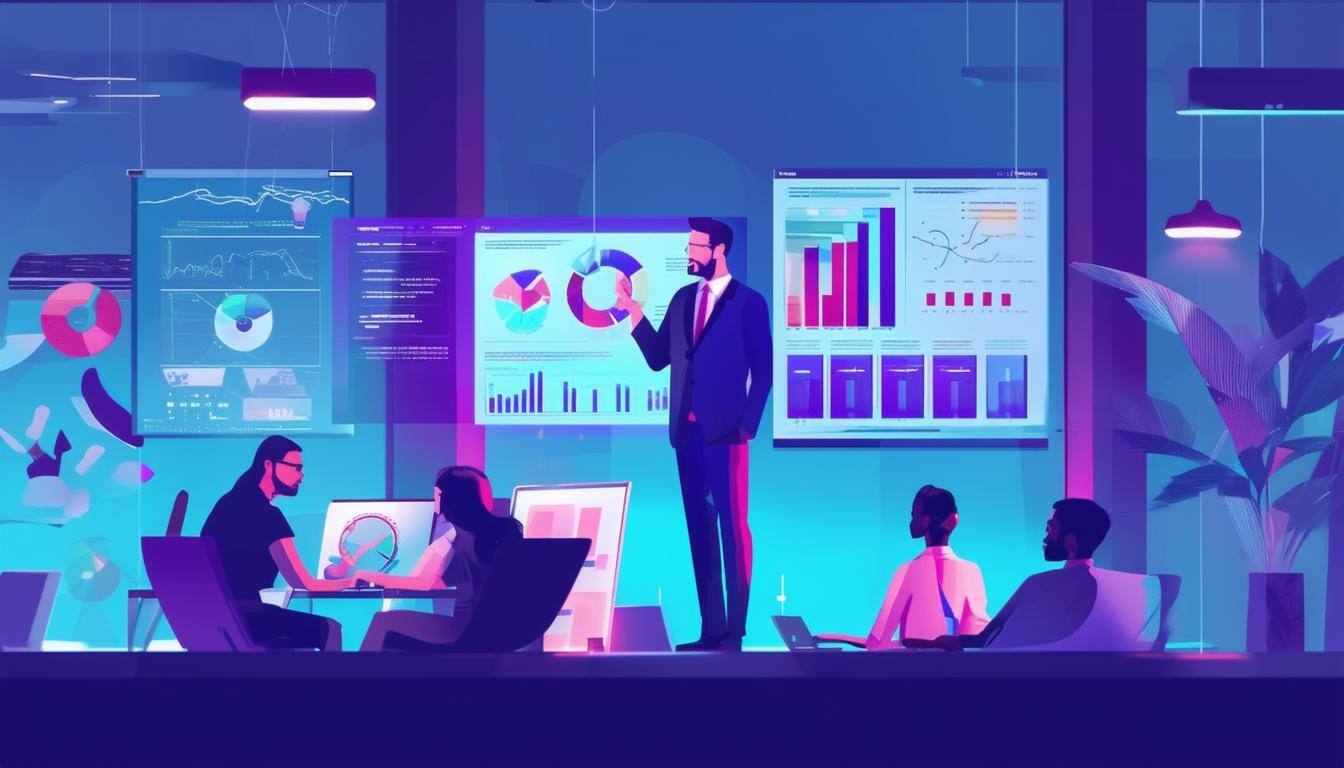Proven Strategies to Reduce Customer Churn in B2B SaaS
In the fast-paced world of B2B SaaS, keeping your customers is the difference between thriving and merely surviving. High churn rates can drain your...
8 min read
Brian Polackoff
:
Sep 5, 2024 9:34:00 AM

In B2B SaaS, keeping customers happy is the key to growing your business and making sure they stick around. By mastering customer success strategies, you'll keep customers satisfied, reduce churn, and build strong loyalty. This article covers the key roles and best practices you need to know, like what a Customer Success Manager does, how to build a great team, onboard new customers smoothly, reduce churn, and measure success. Ready to see how you can make your customers truly successful?
A Customer Success Manager (CSM) is like a gardener for customer relationships in B2B SaaS. Their job is to nurture and grow these relationships, making sure customers get the most out of the product and stay loyal. CSMs are the bridge between the company and the customer, turning customer needs into actionable insights that improve the product and make the overall experience better.
A Customer Success Manager has a wide range of responsibilities, covering different aspects of customer relationships and success metrics. They are responsible for key metrics like customer satisfaction, churn rate, customer health scores, and Net Promoter Score (NPS). Here are their main responsibilities:
A successful CSM in B2B SaaS needs a variety of skills to succeed. They need strong communication skills to build trust, analytical skills to interpret data, and a deep understanding of the product. Additionally, CSMs must be empathetic, problem-solvers, and adaptable to effectively support customers.
Top 10 Skills for Customer Success Managers:
Customer satisfaction is like the heartbeat of B2B SaaS, and the CSM keeps it strong and steady. By staying engaged with customers, quickly addressing their concerns, and providing personalized support, a CSM can greatly improve the customer experience. Regular check-ins and feedback help CSMs understand customer needs and adjust their approach. By advocating for customers within the company, CSMs ensure the product evolves to meet customer expectations, leading to higher satisfaction.
Here are some key questions to consider:
For a small company looking to build their first customer success team, it's important to start simple but effective. Focus on hiring a few key individuals who are passionate about helping customers and are willing to wear multiple hats. A well-rounded, dedicated team can provide great service, help solve customer issues quickly, and significantly impact retention. What makes a team effective? Clear roles and responsibilities, good communication, ongoing training, and a shared focus on customer success. Building strong customer relationships early on will set the foundation for long-term growth and success.
A successful customer success team in B2B SaaS includes several key roles. It's important to note that just because there are different roles doesn't mean they need to be filled by different people—especially in a small company, one person might handle multiple responsibilities. Here are the main roles and their responsibilities:
Customer Success Managers (CSMs):
Customer Support Specialists:
Onboarding Specialists:
Guide new customers through the onboarding process.
Create personalized onboarding plans tailored to customer needs.
Provide training sessions to ensure customers understand key features.
Monitor customer progress during onboarding and offer additional support as needed.
Customer Success Analysts:
Track key success metrics like customer health scores and churn rates.
Analyze customer feedback and usage data to identify trends.
Provide insights to help improve the customer success strategy.
Collaborate with other teams to ensure data-driven decision-making.
Training is important for building a strong customer success team. Continuous learning keeps team members up-to-date with best practices and industry trends. Regular training on product updates, communication skills, and customer management improves performance. Role-playing and peer reviews also help refine skills and build a collaborative environment focused on customer success.
Cross-functional relationships are key to success. CSMs should work with sales to understand customer expectations, with product teams to share feedback, and with marketing to ensure consistent messaging. By sharing information across these teams, CSMs can better understand customer needs and help the company adapt its strategy to improve satisfaction and retention.
Regularly measuring performance is important to make sure the customer success team is meeting its goals. Key performance indicators (KPIs) like customer satisfaction scores, customer health scores, and churn rates provide valuable insights into the team's effectiveness. Here are the key metrics:
Direct Metrics for Customer Success Managers:
Customer Satisfaction Score (CSAT)
Customer Health Score
Churn Rate
Net Promoter Score (NPS)
Metrics Customer Success Managers Influence:
Customer Lifetime Value (CLV)
Product Adoption Rate
Expansion Revenue (upsells and cross-sells)
Customer Engagement Levels
Support Ticket Volume and Resolution Time
Customer Retention Rate
Customer feedback and performance reviews also help identify areas for improvement and recognize successful strategies. By monitoring these metrics, a SaaS company can align its customer success efforts with business goals and improve overall performance.
The onboarding process is a key part of the customer journey. A well-executed onboarding experience not only ensures customers understand how to use the product but also helps them achieve early success, boosting satisfaction and retention. During onboarding, it's important to set clear expectations, provide personalized guidance, and create a supportive environment so customers see the product's value right away. To do this effectively, learn what the customer wants from the start. Ask questions to understand their goals and challenges, and help them get started with what they need most. Tailoring the onboarding experience to their unique needs builds a more meaningful connection and sets the foundation for a positive relationship.
An effective onboarding process in B2B SaaS includes several key steps:
Set clear expectations with the new customer and give an overview of the product's features and benefits.
Create a structured plan with step-by-step guidance, training sessions, and regular check-ins to ensure customers are comfortable using the product.
Provide easy access to resources like tutorials, FAQs, and support channels to enhance the onboarding experience.
Streamline each step to keep the process simple and avoid overwhelming the customer. Use intuitive guidance to make onboarding smooth and stress-free.
Personalize the onboarding experience. Every customer has unique needs and goals, so tailoring the onboarding journey can significantly improve user satisfaction. This could involve customized demos, industry-specific content, or different onboarding paths based on the user's role.
Use engaging content to keep users interested. A mix of tutorials, short videos, interactive guides, and in-app tips makes onboarding both informative and interesting, helping users understand the product's value quickly and easily.
Track key metrics to adjust the onboarding process as needed. Monitor data like time-to-value, engagement rates, and feature adoption to understand how users adapt to the product. Use these insights to refine the onboarding process and address pain points.
Provide proactive support and gather feedback. Offer live chat, access to onboarding specialists, and regular check-ins to make sure customers feel supported. Gathering feedback allows the team to improve the onboarding experience continuously and reduce early churn.
Onboarding can be challenging, but there are ways to tackle common issues. Keep communication clear and provide personalized support to make the process easier. Break down onboarding into small, manageable steps to help customers stay focused. Use interactive tools to keep them engaged, and fix any technical issues quickly to ensure a smooth experience.
Common Onboarding Challenges:
Information Overload: Too much information at once can overwhelm new users. Focus on key features first. (How much information is too much for a new customer to handle in one sitting?)
Lack of Personalization: A generic onboarding process can make users lose interest. Tweak the experience to their needs. (Would you enjoy using a product that feels like it's meant for everyone but you?)
Complex User Interface: Complicated interfaces make onboarding frustrating. Simplify the process to highlight important features. (Is there a simpler way to help users find their way around?)
Slow Time-to-Value: If users don’t see benefits quickly, they may give up. Show value early on. (How soon would you want to see the product working for you?)
Inadequate Support Options: Limited support can make users feel unsupported. Offer easy access to help during onboarding. (What kind of support would make you feel the most comfortable?)
Poorly Defined Success Metrics: Without clear goals, it’s hard to measure success. Define key metrics like feature adoption. (Do your customers know what success looks like when using your product?)
Lack of Engaging Content: Dull or overly technical materials can lose users' attention. Use interesting, easy-to-follow content. (How can you make your onboarding materials more fun and engaging?)
Technical Issues or Bugs: Glitches during onboarding frustrate users. Fix issues fast to keep them on track. (How would you feel if a bug kept you from getting started?)
Unclear Product Value: If users don’t understand how the product helps them, they may lose interest. Make the benefits clear. (Can your customers easily see how your product will make their lives better?)
Inconsistent Follow-Up: Not checking in can lead to disengagement. Follow up regularly to keep users involved. (How often should you reach out to remind customers you're there to help?)
Training new customers is key to their success and happiness. It's like teaching someone to ride a bike—you want to provide training wheels at first, but also encourage them to take off on their own. Offering a mix of live training sessions, webinars, and on-demand tutorials helps meet different learning styles. Hands-on practice and interactive guides make customers comfortable with the product. Regular follow-ups and feedback help make sure they are using the product well and solving any problems they face.
Reducing customer churn rate is a top priority for any SaaS business to help your customer stay engaged. High churn rates can significantly impact revenue and growth. Implementing effective customer success strategies is essential to identify and address the factors that contribute to customer churn rate and enhance the customer success program.
Spotting early signs of churn allows SaaS companies to take action before it's too late. Monitoring customer health scores, engagement levels, and support requests can give early warnings. A sudden drop in usage or negative feedback can also show that a customer might leave. By looking at these signs, companies can reach out to at-risk customers and offer solutions to keep them.
To keep customers, stay proactive, offer personalized support, and always deliver value. Regular check-ins, loyalty programs, and upsell offers based on customer needs help build strong relationships. Creating a customer advocacy program where happy customers share their positive experiences can also boost retention. Making sure the product evolves based on customer feedback and always providing value helps keep customers engaged and loyal.
Customer feedback is a useful tool for reducing churn. Actively asking for feedback through surveys, interviews, and reviews helps SaaS companies understand customer needs and problems. Analyzing this feedback can show areas that need improvement. Letting customers know about the changes made based on their feedback shows commitment to their satisfaction.
Measuring customer success in B2B SaaS means tracking metrics that show customer health and satisfaction. These metrics help see how well customer success strategies are working and guide improvements.
Key metrics for tracking customer success include Customer Satisfaction Score (CSAT), which measures how happy customers are, and Net Promoter Score (NPS), which measures customer loyalty and how likely they are to recommend the product. Customer Lifetime Value (CLV) estimates how much value a customer brings to the company over time. Watching these metrics, along with churn rates and customer health scores, gives a clear picture of customer success.
Customer Lifetime Value (CLV) helps understand the long-term value of a customer. It's calculated by multiplying the average revenue per user (ARPU) by the customer’s average lifespan. A high CLV shows that the company is good at keeping customers and maximizing their value, which is important for sustainable growth.
Improving the Customer Satisfaction Score (CSAT) means delivering value and going beyond customer expectations. Quick and effective support, personalized communication, and continuous product improvements all help improve customer success. Regularly asking for feedback and acting on it helps solve issues and improve the customer experience. By maintaining high-quality service and showing customers they are valued, SaaS companies can achieve higher satisfaction scores and build long-term loyalty.
Now that you've learned about the strategies and tools to master customer success in B2B SaaS, it's time to put them into action. Are you ready to take the challenge of building a truly customer-focused culture? How will you make sure every customer feels valued and supported at every stage of their journey? Remember, customer success is both a strategy and a commitment to helping your customers thrive. So, what steps will you take today to create success stories for your customers and drive your business forward?

In the fast-paced world of B2B SaaS, keeping your customers is the difference between thriving and merely surviving. High churn rates can drain your...

In the rapidly evolving world of Software as a Service (SaaS), customer success is crucial for your business's sustainability and growth. Your...

In the rapidly evolving world of Software as a Service (SaaS), understanding customer churn and retention is crucial for ensuring your business's...